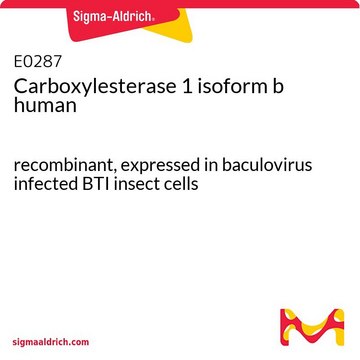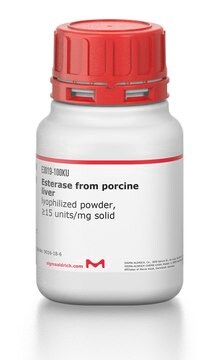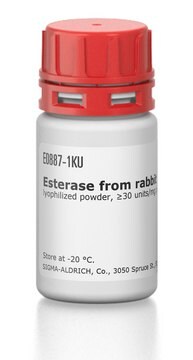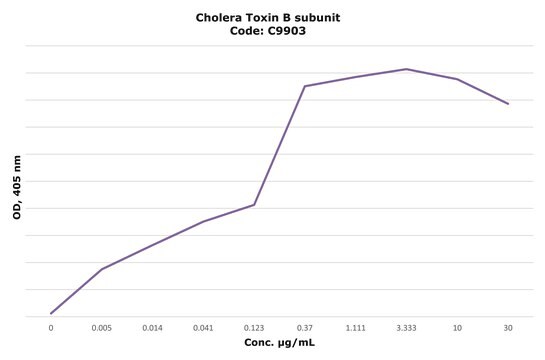Alle Fotos(1)
Wichtige Dokumente
E0412
Carboxylesterase 2 human
recombinant, expressed in baculovirus infected BTI insect cells
Synonym(e):
Carboxylesterase 2 human, CES2, CES2A1
Anmeldenzur Ansicht organisationsspezifischer und vertraglich vereinbarter Preise
Alle Fotos(1)
About This Item
Empfohlene Produkte
Rekombinant
expressed in baculovirus infected BTI insect cells
Qualitätsniveau
Form
liquid
Spezifische Aktivität
≥500 units/mg protein
Mol-Gew.
60 kDa
Gewicht
(0.5 ml)
Versandbedingung
dry ice
Lagertemp.
−70°C
Suchen Sie nach ähnlichen Produkten? Aufrufen Leitfaden zum Produktvergleich
Allgemeine Beschreibung
Carboxylesterase 2 human gene is mapped to human chromosome 16q22.1.
Carboxylesterase belongs to the α/β hydrolase fold family and is involved in drug metabolism and activation. It is present in colon, liver, small intestine, heart, brain and testis. The hydrolase activity of small intestine is attributed to carboxylesterase 2 human. It has two glycosylation sites at 103 and 267 residues with molecular mass 60kDa.
Anwendung
Carboxylesterase 2 human has been used:
- in the in vitro enzyme-based inhibitor screening assay
- in substrate selectivity assay with emission ratiometric two-photon probe (SE1)
- as a reference standard in the enzyme assay with various 4-nitrophenyl and 1-naphthyl based substrates
Carboxylesterase 2 may play a key role in biotransformation of a variety of ester containing drugs and prodrugs.
Delivers high catalytic activity, ideal for robust high-throughput screening assays including drug-drug interaction studies, and pharmacokinetic studies for evaluating pro-drugs and non-CYP pathways of elimination.
Biochem./physiol. Wirkung
Carboxylesterase 2 human identifies the site containing a large alcohol and small acyl group. It shows less transesterification activity due to presence of conformational interference in active site.
Member of a serine esterase family that hydrolyze ester and amide bonds. Carboxylesterase 2 is an endoplasmic reticulum-bound hydrolase that plays a critical role in xenobiotic detoxification and activation for ester-containing therapeutics. Carboxylesterase 2 is also involved in the detoxification of drugs such as heroin and cocaine. This enzyme is thought to play a role in lipid metabolism.
Einheitendefinition
One unit will produce 1 nanomole of 4-nitrophenol from 4-nitrophenyl acetate per minute at pH 7.4 at 37 deg C.
Lagerklassenschlüssel
10 - Combustible liquids
WGK
nwg
Flammpunkt (°F)
Not applicable
Flammpunkt (°C)
Not applicable
Hier finden Sie alle aktuellen Versionen:
Besitzen Sie dieses Produkt bereits?
In der Dokumentenbibliothek finden Sie die Dokumentation zu den Produkten, die Sie kürzlich erworben haben.
Kunden haben sich ebenfalls angesehen
Human liver carboxylesterase. Purification and molecular properties.
W Junge et al.
Archives of biochemistry and biophysics, 165(2), 749-763 (1974-12-01)
T Satoh et al.
Annual review of pharmacology and toxicology, 38, 257-288 (1998-05-23)
Multiple carboxylesterases (EC 3.1.1.1) play an important role in the hydrolytic biotransformation of a vast number of structurally diverse drugs. These enzymes are major determinants of the pharmacokinetic behavior of most therapeutic agents containing ester or amide bonds. Carboxylesterase activity
Tetsuo Satoh et al.
Drug metabolism and disposition: the biological fate of chemicals, 30(5), 488-493 (2002-04-16)
This article reports on a symposium sponsored by the American Society for Pharmacology and Experimental Therapeutics and held at the April 2001 Experimental Biology meeting. Current developments in molecular-based studies into the structure and function of cholinesterases, carboxylesterases, and paraoxonases
Teruko Imai
Drug metabolism and pharmacokinetics, 21(3), 173-185 (2006-07-22)
Human carboxylesterase 1 (hCE-1, CES1A1, HU1) and carboxylesterase 2 (hCE-2, hiCE, HU3) are a serine esterase involved in both drug metabolism and activation. Although both hCE-1 and hCE-2 are present in several organs, the hydrolase activity of liver and small
Jianqin Zhang et al.
Chemosphere, 93(6), 1207-1215 (2013-08-01)
Carboxylesterases (CarEs) play key roles in metabolism of specific hormones and detoxification of dietary and environmental xenobiotics in insects. We sequenced and characterized CarE cDNAs putatively derived from two different genes named LmCesA1 and LmCesA2 from the migratory locust, Locusta
Unser Team von Wissenschaftlern verfügt über Erfahrung in allen Forschungsbereichen einschließlich Life Science, Materialwissenschaften, chemischer Synthese, Chromatographie, Analytik und vielen mehr..
Setzen Sie sich mit dem technischen Dienst in Verbindung.








